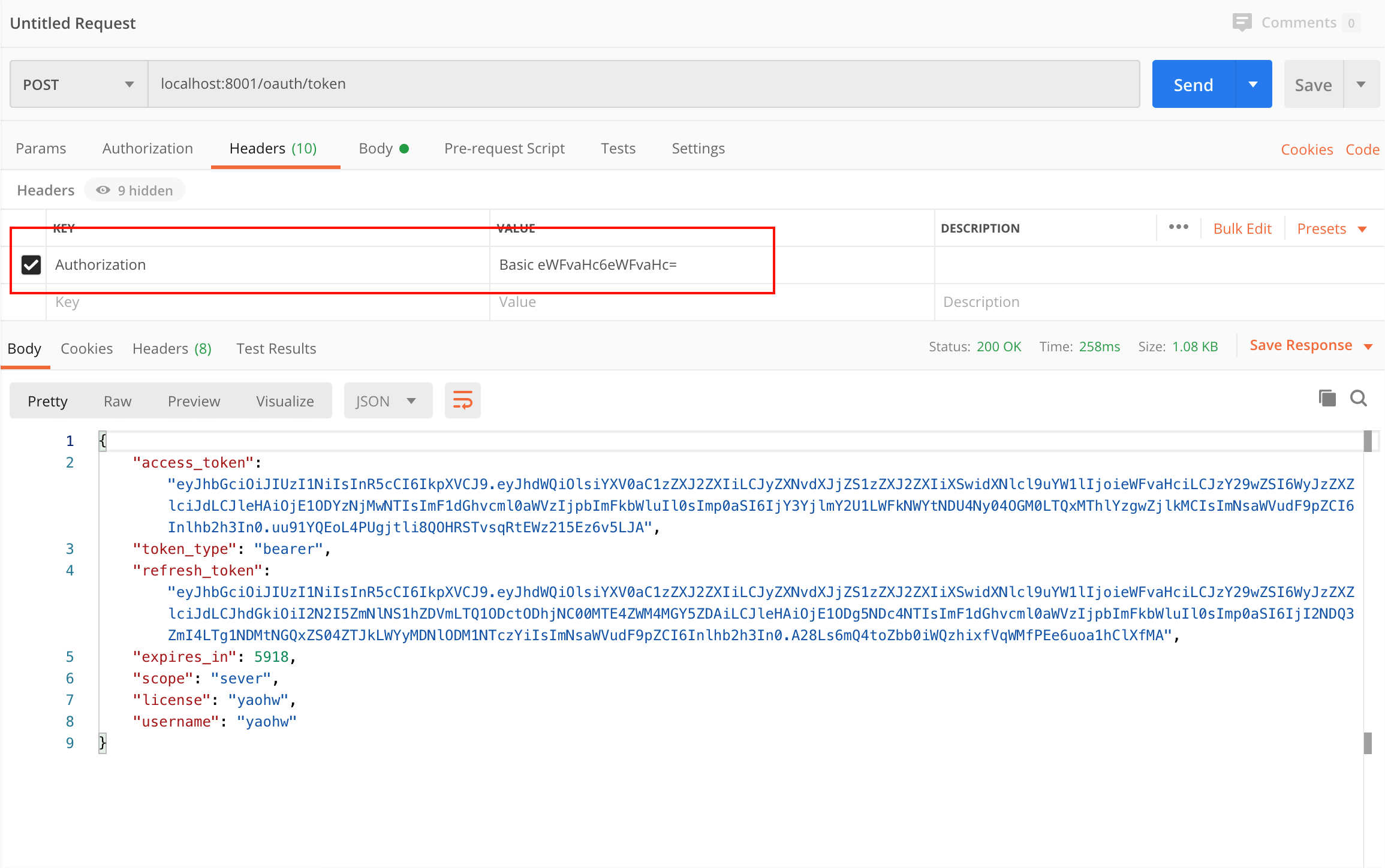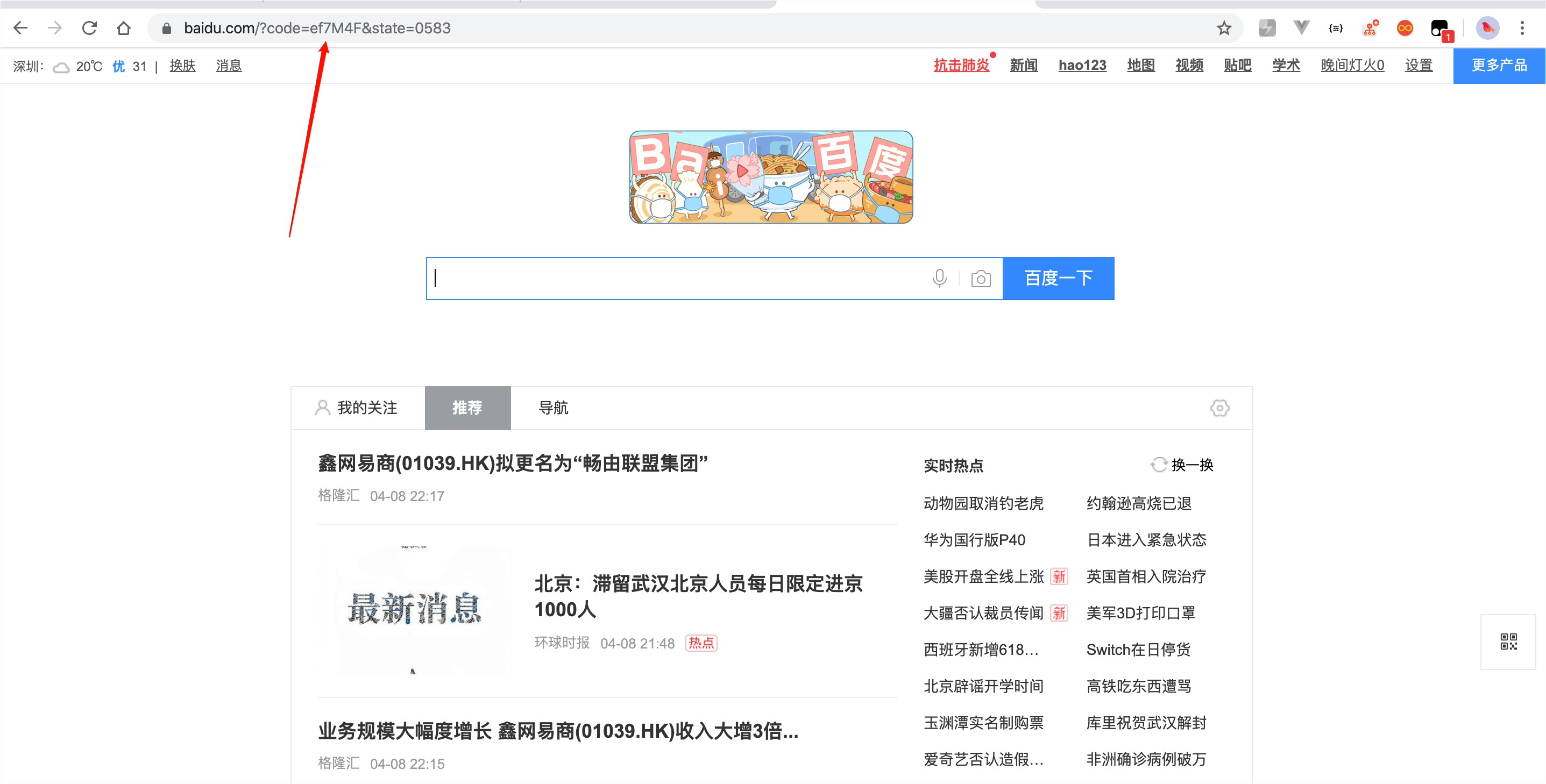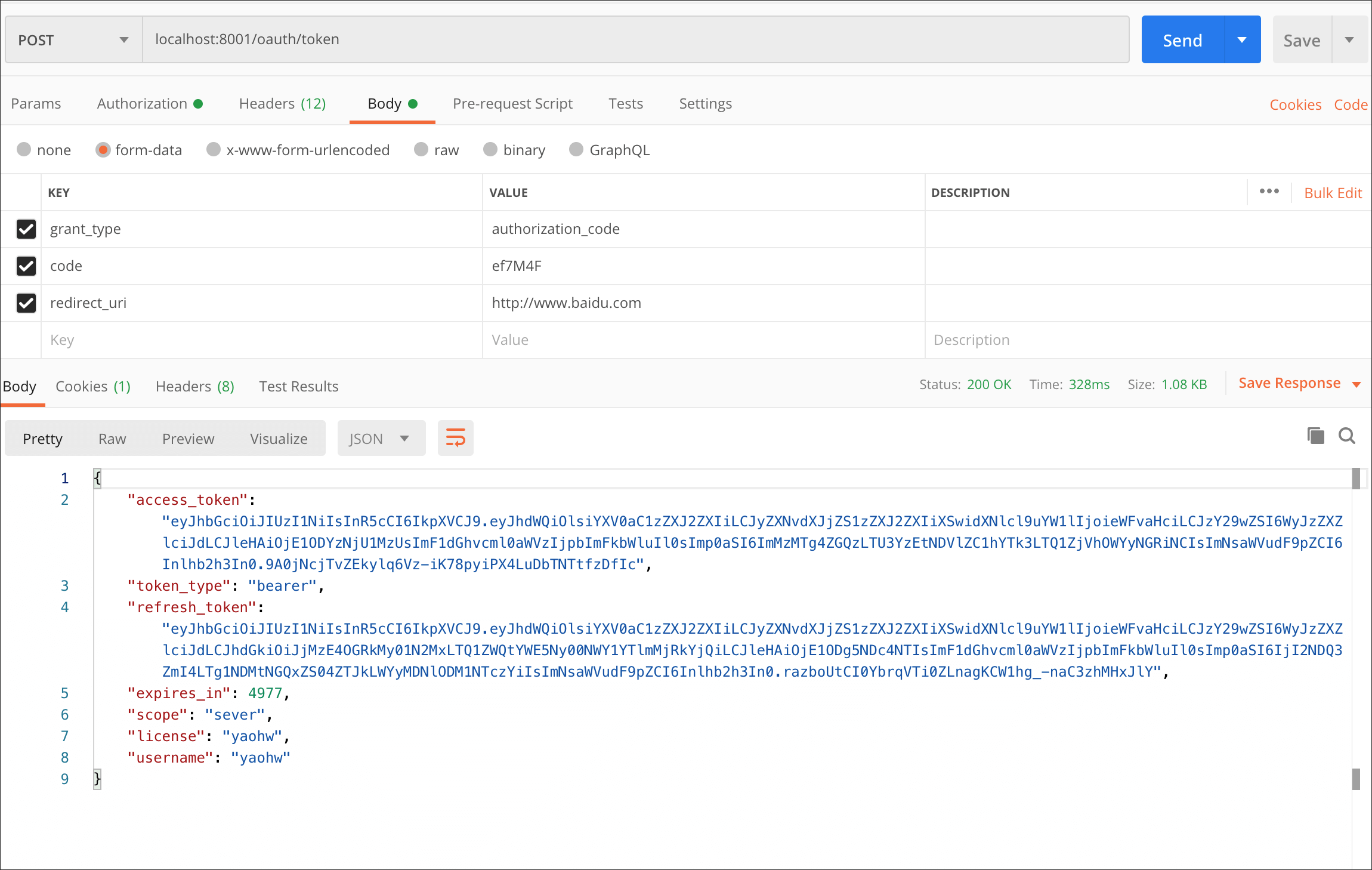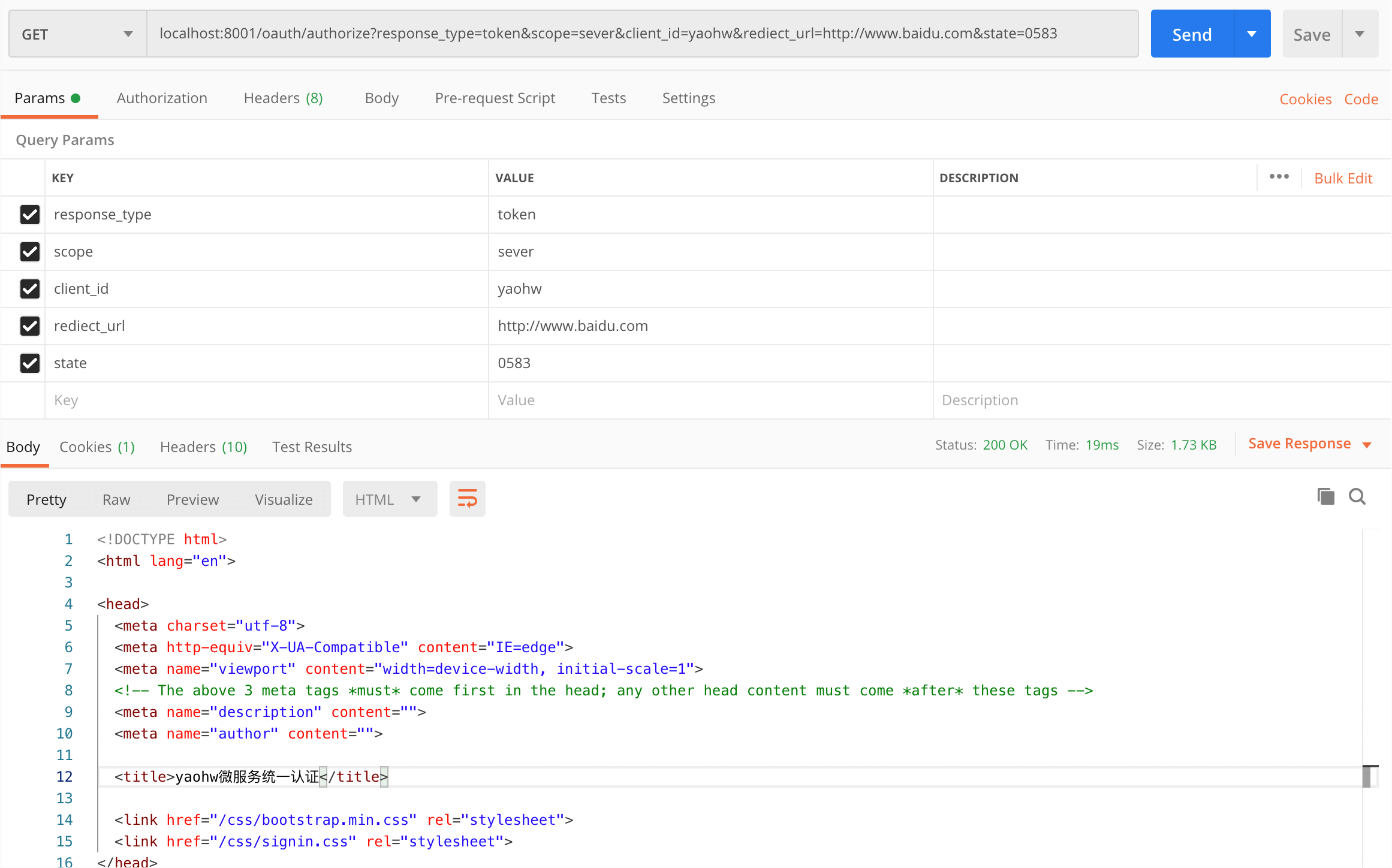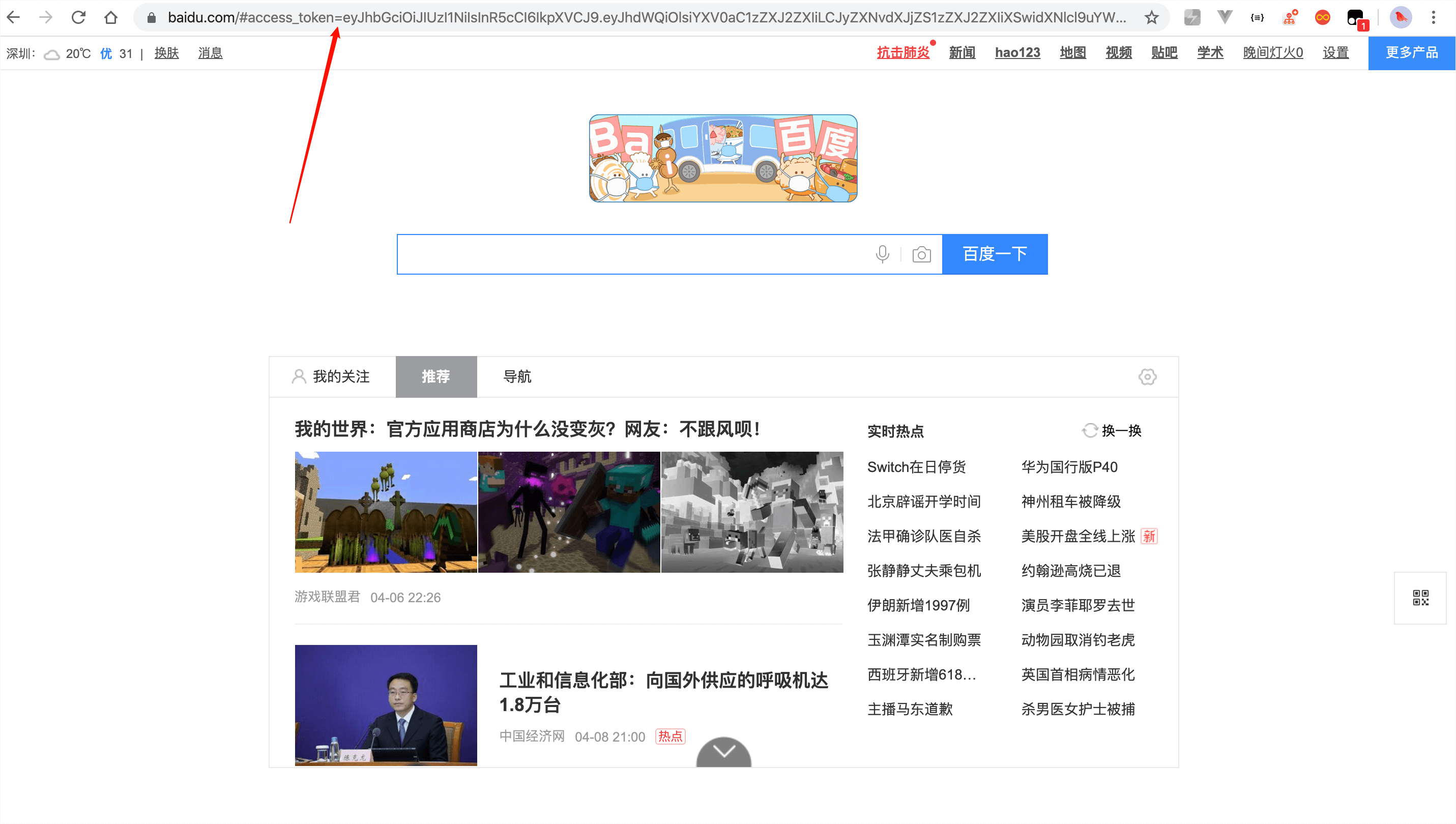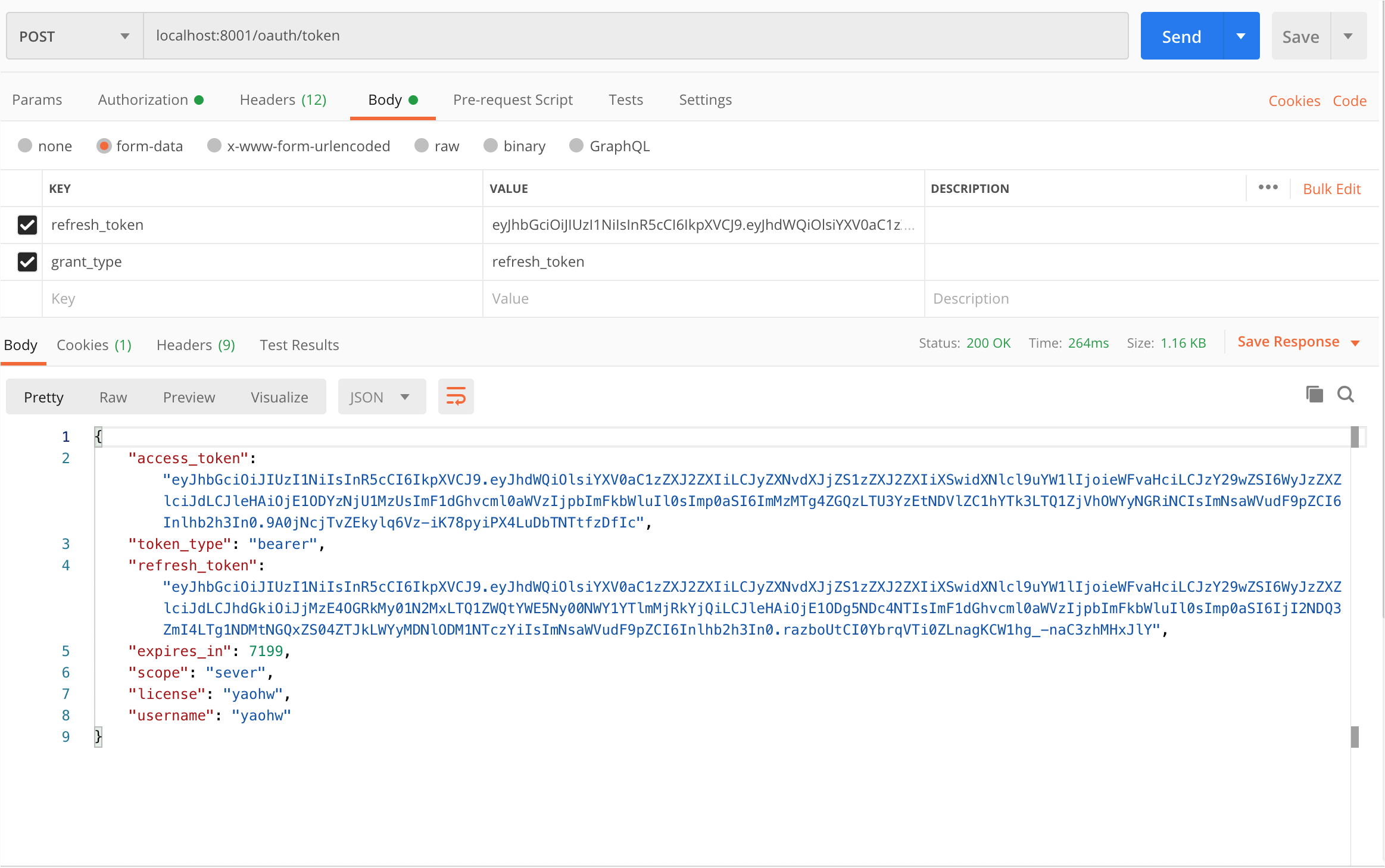本项目基于spring-cloud-starter-oauth2搭建的认证中心和资源服务器的微服务项目,项目不仅仅简单的demo,项目的出发点在于实战应用。本项目为笔者花了不少时间和精力整理出来的,只需要稍微调整就可应用于实际项目当中,并且项目包含大量注释,不仅可以让你会用,也可让你了解到一些流程、一些原理上的东西。认证中心完成密码模式、授权码模式、刷新token模式、简化模式、以及自定义的手机号验证码模式。
国内Gitee:https://gitee.com/copoile/springcloud-oauth2.git
如果大家有什么疑问或不懂的地方可以issue 里提问。 有什么说得不对或不合理的地方也欢迎指出。希望对你有所帮助呦~ ^_^
目前分支有master和prod,master分支为快速上手,未配置数据库,内容偏教程流程理解,prod分支新建数据库相关表,并实现认证相关数据查询,同时实现统一异常处理,统一Api。 prod分支-用户名:admin/123456,客户端:web/123456
- 密码模式
- 自定义手机验证码模式
- 授权码模式
- 简化模式
- 刷token模式
- 退出测试接口
- 简单授权页面
- 不需要accessToken测试接口
- 需要accessToken测试接口
- 需要特定权限测试接口
- scope测试接口
- JDK 1.8 +
- Maven 3.5 +
- IntelliJ IDEA ULTIMATE 2018.2 + (注意:建议使用 IDEA 开发,同时保证安装
lombok插件,如果是eclipse也要确保安装了lombok插件) - Redis 3.0 +
git clone https://github.com/copoile/springcloud-oauth2.git- 使用 IDEA 打开 clone 下来的项目
- 项目启动顺序: eureka-server > auth-server > resource-server
注意:auth-server依赖redis服务,记得先启动redis服务哦~
这里简单做下密码模式的认证和accessToken验证流程,手机号模式跟这个类型,授权码模式和简化模式稍微有点不一样,授权码模式和简化模式都是先跳到认证中心的授权页面,授权成功后回调回调地址,并且携带参数code或accessToken。
/**
* 认证配置
* @author: yaohw
* @create: 2019-09-30 16:12
**/
@Configuration
@EnableAuthorizationServer
public class AuthorizationConfig extends AuthorizationServerConfigurerAdapter {
@Autowired
private AuthenticationManager authenticationManager;
@Autowired
private UserDetailsServiceImpl userDetailsService;
@Autowired
private ClientDetailsServiceImpl clientDetailsService;
@Autowired
private RedisConnectionFactory redisConnectionFactory;
@Autowired
private RedisTemplate<String, Object> redisTemplate;
/**
* 配置token存储,这个配置token存到redis中,还有一种常用的是JwkTokenStore
* jwt的缺点已发布令牌不可控
* @return
*/
@Bean
public TokenStore tokenStore() {
return new RedisTokenStore(redisConnectionFactory);
}
/**
* 配置授权码模式授权码服务(存授权码和删除授权码),不配置默认为内存模式
* @return
*/
@Primary
@Bean
public AuthorizationCodeServices authorizationCodeServices() {
return new RedisAuthorizationCodeServices(redisConnectionFactory);
}
/**
* 配置客户端详情(根据客户的id查询客户端)
* @param clients
* @throws Exception
*/
@Override
public void configure(ClientDetailsServiceConfigurer clients) throws Exception {
clients.withClientDetails(clientDetailsService);
}
@Override
public void configure(AuthorizationServerEndpointsConfigurer endpoints) throws Exception {
// 采用token转jwt,并添加一些自定义信息(token增强)
// 默认使用随机UUID生成的token
TokenEnhancerChain tokenEnhancerChain = new TokenEnhancerChain();
tokenEnhancerChain.setTokenEnhancers(
Arrays.asList(jwtAccessTokenConverter(),tokenEnhancer()));
endpoints.tokenEnhancer(tokenEnhancerChain)
// 配置token存储,一般配置redis存储
.tokenStore(tokenStore())
// 配置认证管理器
.authenticationManager(authenticationManager)
// 配置用户详情server,密码模式必须
.userDetailsService(userDetailsService)
// 配置授权码模式授权码服务,不配置默认为内存模式
.authorizationCodeServices(authorizationCodeServices())
// 配置grant_type模式,如果不配置则默认使用密码模式、简化模式、验证码模式以及刷新token模式,如果配置了只使用配置中,默认配置失效
// 具体可以查询AuthorizationServerEndpointsConfigurer中的getDefaultTokenGranters方法
.tokenGranter(tokenGranter(endpoints));
// 配置TokenServices参数
DefaultTokenServices tokenServices = new DefaultTokenServices();
tokenServices.setTokenStore(endpoints.getTokenStore());
// 是否支持刷新Token
tokenServices.setSupportRefreshToken(true);
tokenServices.setReuseRefreshToken(true);
tokenServices.setClientDetailsService(endpoints.getClientDetailsService());
tokenServices.setTokenEnhancer(endpoints.getTokenEnhancer());
// 设置accessToken和refreshToken的默认超时时间(如果clientDetails的为null就取默认的,如果clientDetails的不为null取clientDetails中的)
tokenServices.setAccessTokenValiditySeconds((int) TimeUnit.HOURS.toSeconds(2));
tokenServices.setRefreshTokenValiditySeconds((int) TimeUnit.DAYS.toSeconds(30));
endpoints.tokenServices(tokenServices);
}
/**
* jwt格式封装token
* @return
*/
@Bean
public JwtAccessTokenConverter jwtAccessTokenConverter() {
JwtAccessTokenConverter jwtAccessTokenConverter = new JwtAccessTokenConverter();
// 设置jwt加解密秘钥,不设置会随机一个
jwtAccessTokenConverter.setSigningKey("yaohw");
return jwtAccessTokenConverter;
}
/**
* token增强,添加一些元信息
*
* @return TokenEnhancer
*/
@Bean
public TokenEnhancer tokenEnhancer() {
return (accessToken, authentication) -> {
final Map<String, Object> additionalInfo = new HashMap<>(2);
additionalInfo.put("license", "yaohw");
UserDetailImpl user = (UserDetailImpl) authentication.getUserAuthentication().getPrincipal();
if (user != null) {
additionalInfo.put("username", user.getUsername());
}
((DefaultOAuth2AccessToken) accessToken).setAdditionalInformation(additionalInfo);
return accessToken;
};
}
@Override
public void configure(AuthorizationServerSecurityConfigurer security) throws Exception {
security
.allowFormAuthenticationForClients()
.tokenKeyAccess("isAuthenticated()")
.checkTokenAccess("permitAll()");
}
/**
* 创建grant_type列表
* @param endpoints
* @return
*/
private TokenGranter tokenGranter(AuthorizationServerEndpointsConfigurer endpoints) {
List<TokenGranter> list = new ArrayList<>();
// 这里配置密码模式、刷新token模式、自定义手机号验证码模式、授权码模式、简化模式
list.add(new ResourceOwnerPasswordTokenGranter(authenticationManager, endpoints.getTokenServices(), endpoints.getClientDetailsService(), endpoints.getOAuth2RequestFactory()));
list.add(new RefreshTokenGranter(endpoints.getTokenServices(), endpoints.getClientDetailsService(), endpoints.getOAuth2RequestFactory()));
list.add(new MobileCodeTokenGranter(authenticationManager,endpoints.getTokenServices(), endpoints.getClientDetailsService(), endpoints.getOAuth2RequestFactory()));
list.add(new AuthorizationCodeTokenGranter(endpoints.getTokenServices(),endpoints.getAuthorizationCodeServices(), endpoints.getClientDetailsService(), endpoints.getOAuth2RequestFactory()));
list.add(new ImplicitTokenGranter(endpoints.getTokenServices(),endpoints.getClientDetailsService(),endpoints.getOAuth2RequestFactory()));
return new CompositeTokenGranter(list);
}
}/**
* security web安全配置,spring-cloud-starter-oauth2依赖于security
* 默认情况下SecurityConfigurerAdapter执行比ResourceServerConfig先
* @author: yaohw
* @create: 2019-09-25 16:49
*/
@Configuration
@EnableWebSecurity
public class SecurityConfigurerAdapter extends WebSecurityConfigurerAdapter {
@Autowired
private UserDetailsServiceImpl userDetailsService;
@Autowired
private StringRedisTemplate stringRedisTemplate;
/**
* 配置认证管理器
*
* @return
* @throws Exception
*/
@Bean
@Override
public AuthenticationManager authenticationManagerBean() throws Exception {
return super.authenticationManagerBean();
}
/**
* 配置密码加密对象(解密时会用到PasswordEncoder的matches判断是否正确)
* 用户的password和客户端clientSecret用到,所以存的时候存该bean encode过的密码
*
* @return
*/
@Bean
public PasswordEncoder passwordEncoder() {
return new BCryptPasswordEncoder();
}
/**
* 这里是对认证管理器的添加配置
*
* @param auth
* @throws Exception
*/
@Override
protected void configure(AuthenticationManagerBuilder auth) throws Exception {
auth.authenticationProvider(provider())
.userDetailsService(userDetailsService)
.passwordEncoder(new BCryptPasswordEncoder());
}
@Override
public void configure(WebSecurity web) throws Exception {
web.ignoring().antMatchers("/css/**","/static/**");
}
/**
* 安全请求配置,这里配置的是security的部分,这里配置全部通过,安全拦截在资源服务的配置文件中配置,
* 要不然访问未验证的接口将重定向到登录页面,前后端分离的情况下这样并不友好,无权访问接口返回相关错误信息即可
* @param http
* @return void
*/
@Override
protected void configure(HttpSecurity http) throws Exception {
http
.formLogin().loginPage("/login")
.permitAll()
.and().authorizeRequests().anyRequest().permitAll()
.and().csrf().disable().cors();
}
/**
* 自定义手机验证码认证提供者
*
* @return
*/
@Bean
public MobileCodeAuthenticationProvider provider() {
MobileCodeAuthenticationProvider provider = new MobileCodeAuthenticationProvider();
provider.setStringRedisTemplate(stringRedisTemplate);
provider.setHideUserNotFoundExceptions(false);
provider.setUserDetailsService(userDetailsService);
return provider;
}
}/**
* 资源服务配置
* @author: yaohw
* @create: 2019-10-08 10:04
**/
@Configuration
// 启用资源服务
@EnableResourceServer
// 启用方法级权限控制
@EnableGlobalMethodSecurity(prePostEnabled = true)
@Log4j2
public class ResourceServerConfig extends ResourceServerConfigurerAdapter {
private static final String RESOURCE_ID = "auth-server";
/**
* 配置资源接口安全,http.authorizeRequests()针对的所有url,但是由于登录页面url包含在其中,这么配置会进行token校验,校验不通过返回错误json,
* 而授权码模式获取code时需要重定向登录页面,重定向过程并不能携带token,所有不能用http.authorizeRequests(),
* 而是用requestMatchers().antMatchers(""),这里配置的是需要资源接口拦截的url数组
* @param http
* @return void
*/
@Override
public void configure(HttpSecurity http) throws Exception {
http //配置需要保护的资源接口
.requestMatchers().antMatchers("/user","/test/need_token","/update","/logout","/test/need_admin","/test/scope")
.and().authorizeRequests().anyRequest().authenticated();
}
@Override
public void configure(ResourceServerSecurityConfigurer resources) throws Exception {
resources.resourceId(RESOURCE_ID).stateless(true);
}
}spring:
application:
name: resource-server
server:
port: 8003
#服务器发现注册配置
eureka:
client:
serviceUrl:
#配置服务中心(可配置多个,用逗号隔开)
defaultZone: http://admin:admin@localhost:9000/eureka/
##安全配置##
security:
oauth2:
resource:
id: resource-server
## user-info-uri和token-info-uri二选择即可
## 如果配置了user-info-uri,该资源服务器使用userInfoTokenServices远程调用认证中心接口,通过认证中心的OAuth2AuthenticationProcessingFilter完成验证工作,一般设置user-info-uri即可
user-info-uri: http://127.0.0.1:8001/user
prefer-token-info: false
## 该资源服务器使用RemoteTokenServices远程调用认证中心接口,注意一点就是如果使用token-info-uri那么就必须设置上clientId和clientSecret,通过CheckTokenEndpoint完成验证工作
#token-info-uri: http://127.0.0.1:8001/oauth/check_token
#client:
#client-secret: yaohw
#client-id: yaohw @RequestMapping(value = "/oauth/token", method=RequestMethod.POST)
public ResponseEntity<OAuth2AccessToken> postAccessToken(Principal principal, @RequestParam
Map<String, String> parameters) throws HttpRequestMethodNotSupportedException {
if (!(principal instanceof Authentication)) {
throw new InsufficientAuthenticationException(
"There is no client authentication. Try adding an appropriate authentication filter.");
}
// 根据当前请求获取到clientId
String clientId = getClientId(principal);
// 获取当前ClientDetailsService(就是我们在AuthorizationConfig中配置)然后根据clientId去数据库查询客户端详情
ClientDetails authenticatedClient = getClientDetailsService().loadClientByClientId(clientId);
// 将请求参数封装成TokenRequest
TokenRequest tokenRequest = getOAuth2RequestFactory().createTokenRequest(parameters, authenticatedClient);
// 请求的clientId与查出来的匹配
if (clientId != null && !clientId.equals("")) {
// Only validate the client details if a client authenticated during this
// request.
if (!clientId.equals(tokenRequest.getClientId())) {
// double check to make sure that the client ID in the token request is the same as that in the
// authenticated client
throw new InvalidClientException("Given client ID does not match authenticated client");
}
}
// 校验客户端范围
if (authenticatedClient != null) {
oAuth2RequestValidator.validateScope(tokenRequest, authenticatedClient);
}
if (!StringUtils.hasText(tokenRequest.getGrantType())) {
throw new InvalidRequestException("Missing grant type");
}
// 判断是否是简化模式(简化模式不是这个接口,走的是AuthorizationEndpoint类下的/oauth/authorize)
if (tokenRequest.getGrantType().equals("implicit")) {
throw new InvalidGrantException("Implicit grant type not supported from token endpoint");
}
// 判断是否授权码模式,如果是,清空返回,因为授权码模式在第一步获取code的时候就将client信息缓存起来的,后面检验的是从缓存取出来补充完整
if (isAuthCodeRequest(parameters)) {
// The scope was requested or determined during the authorization step
if (!tokenRequest.getScope().isEmpty()) {
logger.debug("Clearing scope of incoming token request");
tokenRequest.setScope(Collections.<String> emptySet());
}
}
// 是否刷新token模式
if (isRefreshTokenRequest(parameters)) {
// A refresh token has its own default scopes, so we should ignore any added by the factory here.
tokenRequest.setScope(OAuth2Utils.parseParameterList(parameters.get(OAuth2Utils.SCOPE)));
}
// 这步是整个认证的关键,这里简单说下流程,首先她会根据当前请求的grantType找到对应的认证模式,
// 比如密码模式的ResourceOwnerPasswordTokenGranter,
// 然后对应的AbstractTokenGranter调用对应的grant方法,grant方法中又调用经过一系列调用,
// 在getOAuth2Authentication方法中生成对应的AbstractAuthenticationToken,比如UsernamePasswordAuthenticationToken,
// 然后认证管理器(就是我们在AuthorizationConfig中配置的AuthenticationManager)调用认证方法authenticationManager.authenticate(abstractAuthenticationToken)
// AbstractAuthenticationToken和AuthenticationProvider是存在一一对应的关系
// 比如UsernamePasswordAuthenticationToken和DaoAuthenticationProvider,
// authenticationManager.authenticate()会根据传入的
// AbstractAuthenticationToken找到对应的AuthenticationProvider,
// 真正认证逻辑通过AuthenticationProvider来完成的,比如密码模式的DaoAuthenticationProvider,
// 会去根据用户名查询出对应的用户,
// 然后校验用户密码是否匹配,用户是否锁定过期等
// 具体可查看DaoAuthenticationProvider和她继承的AbstractUserDetailsAuthenticationProvider
// 理清上面的思路后,我们就可以自定义grantType
// 就是定义一个继承AbstractTokenGranter的类重写getOAuth2Authentication方法
// 该方法里面会用到AbstractAuthenticationToken和AuthenticationProvider
// 我们再分别定义一个类分别继承对应的类即可(大概思路,具体查看代码)
OAuth2AccessToken token = getTokenGranter().grant(tokenRequest.getGrantType(), tokenRequest);
if (token == null) {
throw new UnsupportedGrantTypeException("Unsupported grant type: " + tokenRequest.getGrantType());
}
//这个没什么好说的,就是http请求响应体封装
return getResponse(token);
}了解过OAuth2的同学应该知道它有资源服务和认证中心服务,那么它怎么保护资源服务接口的呢?实际上不管认证中服务还是资源服务,当请求的接口需要安全校验时都会被OAuth2ClientAuthenticationProcessingFilter所拦截,只是拦截后做了不同的处理(取决于ResourceServerTokenServices的实例)。资源服务:拦截请求后会远程调用认证服务器的http://127.0.0.1:8001/user或http://127.0.0.1:8001/oauth/check_token,至于调用哪个取决于配置文件,如配置如下配置将远程调用http://127.0.0.1:8001/user(资源服务端我们也一般这么配置即可)
##安全配置##
security:
oauth2:
resource:
id: resource-server
user-info-uri: http://127.0.0.1:8001/user
prefer-token-info: falsepublic void doFilter(ServletRequest req, ServletResponse res, FilterChain chain) throws IOException,
ServletException {
final boolean debug = logger.isDebugEnabled();
final HttpServletRequest request = (HttpServletRequest) req;
final HttpServletResponse response = (HttpServletResponse) res;
try {
Authentication authentication = tokenExtractor.extract(request);
Authentication authResult = authenticationManager.authenticate(authentication);
....略
// 这步是校验token的关键,这里tokenServices是ResourceServerTokenServices实例,这里做怎么样的操作取决于注入的
// ResourceServerTokenServices实例
// 默认情况下ResourceServerTokenServices的实例是DefaultTokenServices
// 认证中心使用的就是DefaultTokenServices,这个类做的就是tokenStore.readAccessToken(accessTokenValue)
// 我们配置中心配置的tokenStore的是RedisTokenStore,所以实际上她做的就是从redis中读取出accessToken相关信息
<!-- 分割线 --->
// 上面说的DefaultTokenServices是认证中心token的处理,资源服务下:
// 如果配置文件中配置的user-info-uri则ResourceServerTokenServices注入的实例将是UserInfoTokenServices的实例
// 如果配置token-info-uri则ResourceServerTokenServices注入的实例将是RemoteTokenServices
// 如果两者都配置了,优先UserInfoTokenServices
// UserInfoTokenServices和RemoteTokenServices做的事都是远程调度认证中心相应的接口完成token的校验
// 两者主要区别在于RemoteTokenServices需要配置clientId和clientSecret
// RemoteTokenServices中有这么一句话:Null Client ID or Client Secret detected. Endpoint that requires authentication will reject // request with 401 error. // 具体请查看RemoteTokenServices和UserInfoTokenServices
// OAuth2AuthenticationManager.java
String token = (String) authentication.getPrincipal();
OAuth2Authentication auth = tokenServices.loadAuthentication(token);
}
}这里两种方式都是一样的,eWFvaHc6eWFvaHc=其实就是yaohw:yaohw,经过base64加密了一下
注意:需要在redis中设置一个缓存,String类型,key为sms:code:你的手机号,值为短信验证码
授权码模式步骤一 会跳转到认证中心的授权页面,这里为方便展示参数才用postman,get请求,应在浏览器直接打开(带对应参数),授权成功后会回调回调地址,并且会携带code。

与授权码模式类似,不过回调后携带的参数不是code,还是access_token,比授权码模式少了一步.
简化模式步骤一会跳转到认证中心的授权页面,这里为方便展示参数才用postman,get请求,应在浏览器直接打开(带对应参数),授权成功后会回调回调地址,并且会携带accessToken。
Copyright (c) 2019-present Yaohw


